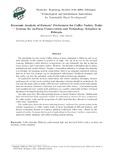| dc.contributor.author | Wale, Edilegnaw | |
| dc.contributor.author | Mburu, John | |
| dc.date.accessioned | 2013-07-25T06:05:42Z | |
| dc.date.available | 2013-07-25T06:05:42Z | |
| dc.date.issued | 2003 | |
| dc.identifier.citation | Edilegnaw Wale and John Mburu (2003). Economic Analysis of Farmers’ Preferences for Coffee Variety Traits — Lessons for on-Farm Conservation and Technology Adoption in Ethiopia. Deutscher Tropentag, October 8-10, G¨ottingen | en |
| dc.identifier.uri | http://www.google.com/url?sa=t&rct=j&q=&esrc=s&source=web&cd=5&ved=0CEMQFjAE&url=http%3A%2F%2Fwww.tropentag.de%2F2003%2Fabstracts%2Flinks%2FWale_ZtYfOYQw.pdf&ei=5r7wUZmhA-6y0AXrjoDwBA&usg=AFQjCNFGA27sQZgaNXNYMbxqYbb7XR_YSA&bvm=bv.49784469,d.d2k | |
| dc.identifier.uri | http://hdl.handle.net/11295/50834 | |
| dc.description.abstract | The knowledge to-date recaps Coffea arabica to have originated in Ethiopia and its genetic
diversity in the country is proved to be high. On top of its role in the national
economy, Ethiopia’s coffee diversity is important not only nationally but also in international
research and conservation centers. However, this diversity is dwindling due to policy,
institutional and market failures. Despite a tremendous attention to salvage this degradation
through the emerging on-farm conservation, there is no adequate contextual research
done as to how this strategy can be harmonized with farmers’ livelihood strategies and
how policy can face the potential trade-off with modern technology adoption.
To implement sensible on-farm conservation and variety adoption strategies, farmers’
preferences for variety traits and their land allocation behavior should be understood. To
this end, the paper aims to study coffee farmers’ preferences for variety traits and examine
land use decisions (between traditional and improved coffee trees). A household model
that considers farmers’ variety trait preferences as a positive externality of their livelihood
decisions is developed drawing from Lancaster’s characteristics model.
The data come from 266 coffee growing farmers in South Western Ethiopia. Multinomial
logit and two-limit Tobit regression models are estimated to examine farmers’ preferences
for coffee variety traits and the proportion of coffee land that they allocate to traditional
coffee trees, respectively.
The results have shown the factors inducing farmers’ preference for certain variety traits,
relative importance of coffee variety traits to farm households of different features, and
factors motivating farmers to continue planting traditional coffee trees. Based on the
empirical results, the paper derives policy implications in the areas of on-farm conservation,
improved variety adoption, and coffee breeding priority setting. | en |
| dc.language.iso | en | en |
| dc.title | Economic Analysis of Farmers’ Preferences for Coffee Variety Traits — Lessons for on-Farm Conservation and Technology Adoption in Ethiopia | en |
| dc.type | Presentation | en |

